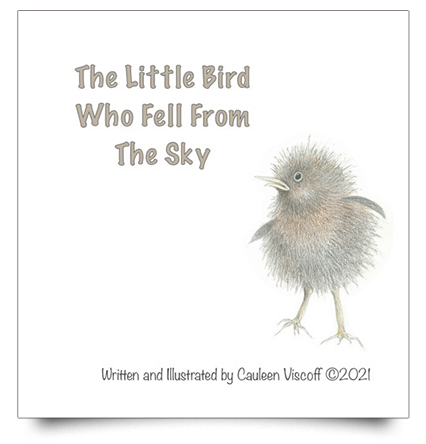I’d love to connect with you! Sign up for my monthly newsletter, "Garden Bliss & Blunder”
RAIN GARDENS
and
CLIMATE CHANGE
WHAT DOES CLIMATE CHANGE
HAVE TO DO WITH ME?
No matter how much I read about it, climate change doesn’t seem real to me. The words make me feel helpless because the climate is out of my hands.
- isn’t it?
One definition of climate change left me yawning…. it reads:
“Climate change is caused by factors such as biotic processes, variations in solar radiation received by Earth, plate tectonics, and volcanic eruptions” - (Wikipedia)
Really?
Then it says: “certain human activities have also been identified as significant causes of recent climate change, often referred to as "global warming”. (Wikipedia)
Do you understand what this means?
I don’t
And so I cluck my tongue in disgust when I read about this big bad boy corporation or that polluting giant. But still, it hasn’t quite hit close to home…yet.
But on Oscar night, I heard someone speak who does understand: here’s what he said:
“Climate change is real, it is happening right now. It is the most urgent threat facing our entire species, and we need to work collectively together and stop procrastinating. We need to support leaders around the world who do not speak for the big polluters, but who speak for all of humanity, for the indigenous people of the world, for the billions and billions of underprivileged people out there who would be most affected by this. For our children’s children, and for those people out there whose voices have been drowned out by the politics of greed. I thank you all for this amazing award tonight. Let us not take this planet for granted. I do not take tonight for granted. Thank you so very much.”
From Leonardo DiCaprio’s Oscar acceptance speech 2016:
Thinking it over, I have seen more storms and odd glitches in temperature or rainfall, but as a gardener, I tuck inside in the winter to research and write, and then deal with the differences by changing plants, or adding mulch in the summer.
But recently, I learned there are things I can do. I had the privilege of taking a “rain garden certification training” class with Master Raingardener, Rusty Schmidt. I confess the course appealed to me because it said “garden”.
So here is what changes some of the helplessness and empowers me to both make a difference where I can and teach y’all to do the same.
(Rusty would slip in a “y’all” now and then and everything sounded friendlier somehow)
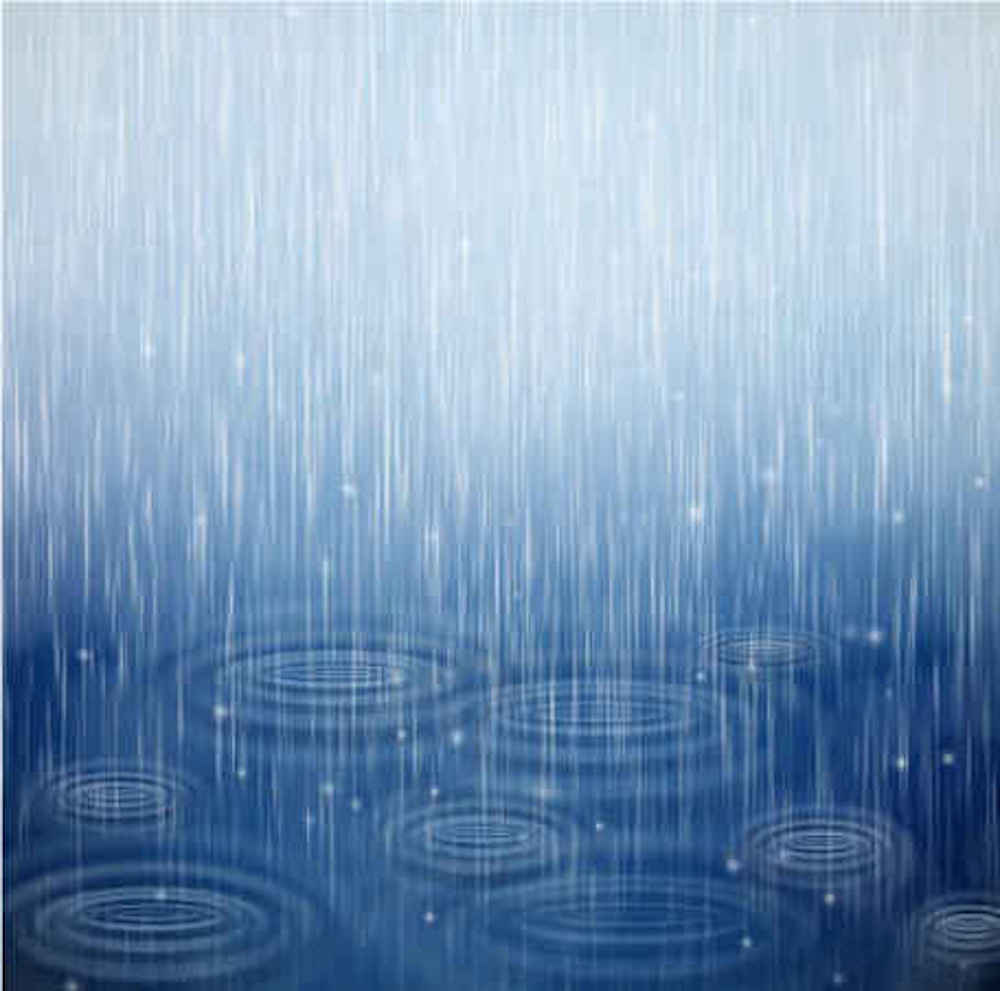
Source: Blue raindrops from Clipart.me
We need to talk about “stormwater”. If you’re like me, I never thought much about stormwater - except on those days where it poured rain and I had to clean the gunk out of the storm drain to let the water drain away… I don’t know much about the flood risks even though our city experienced a major flood in the last decade…. or about the pollution that runoff causes and the results of all that.
Nor did I have any idea what I could do on my own property to help some of these issues.
But let me back up: …rain falls…
In the woods, rainfall is broken by the trees and is then absorbed into the forest floor; filtered by the soil and vegetation. Not much runs off into neighbouring streams or rivers.
But when we turn those forests into asphalt jungles with houses instead of trees, we find that our roofs, driveways, streets and sidewalks (called impervious surfaces) do not absorb water. The rain runs off them to the streets and down into the storm drains, collecting crud like oil, trash, doggy waste, salt, sand, lawn and garden fertilizers, soap residue from our driveways, dead leaves and sticks along the way. Yuk.
Do you know that every time we touch the brakes on our car we deposit both cadmium and zinc on our streets? Rain washes those heavy metals into the storm drain.
Do you also know that each pound of leaves we let go down our storm drain contains enough Phosphorous to bloom up to 10 pounds of algae? I didn’t…
And what about this?
How much rain do you think runs off your roof during a one- inch rainfall?
Let’s calculate the number of gallons of runoff from your roof in a 1”rainfall : (litres use the same formula but doesn’t look as tidy)
Let’s say your roof footprint is 50 feet by 20 feet
(turn into inches) = 600 in. by 240 in.
Multiply roof size by number of inches of rainfall
600 in. x 240 in. x 1 in. = 144,000 cubic inches of rain
Divide by 231 (231 cu. in. = 1 gallon)
144,000 /231 = 623.38 gallons of rainwater…
wow, that’s a lot of water!
Then add the sq. footage of both your driveway and your lawn; put all that into the formula….that makes a lot of gallons of rain.
Now that climate change seems responsible for an increased rainfall in some areas, and there are more houses and streets in those same areas, there is no other place for that rain to go but into the storm drains.
Imagine if those 623 gallons from just your roof are multiplied by every house on your block and it all goes into just one storm drain… think of the magnitude of this and then for every street in town and the impact it has on our city’s sewer infrastructure.
It’s almost unimaginable.
And when all that water does go down the drain, it is added to the grey water from our homes. No wonder we get flooding. No wonder the storm drain gets clogged and overflows onto our lawns and gardens and the sewers back up. Those underground drains cannot handle the huge amount of water demanded of them….
What can we do?
When rain falls:
Slow it down
Soak it up
Keep it clean.
How do we do this?
The new term is ”Green Stormwater Infrastructure”.
A phrase I confess makes my eyes glaze over.
It means creating spaces inside the city that allow the rainfall to soak into the ground by recreating how nature does it. Finding ways to soak it in, as well as keeping much of the rain out of the sewers; it helps to reduce pollution; and begins to “manage the rain where it falls, while healing the urban water cycle”.
How do those spaces look?
They look like gardens: “rain gardens”, green roofs, “rainwater harvesting” (rain barrels) and permeable pavement (some of these are are interlocking, strong porous pavers that allow water to soak into the ground.
It means looking at our properties to see where the rain runs off the roof and finding the low spots where water pools: looking at where our downspouts flow and if the water that runs off our lawns and driveways runs to our neighbours yard.
And then building rain gardens to let that rainfall slow down, soak in and filter out pollutants with plants. Some plants that are ideal have deep roots - some a deep as 5 feet, like the Purple Coneflower (Echinacea purpurea),some grasses and scads of others. (raingardenalliance.org)
It’s about working with nature and following her example to let rain go back to the water table instead of to the storm drain or down the sides of our houses to our basements.
It could be as simple as this below:
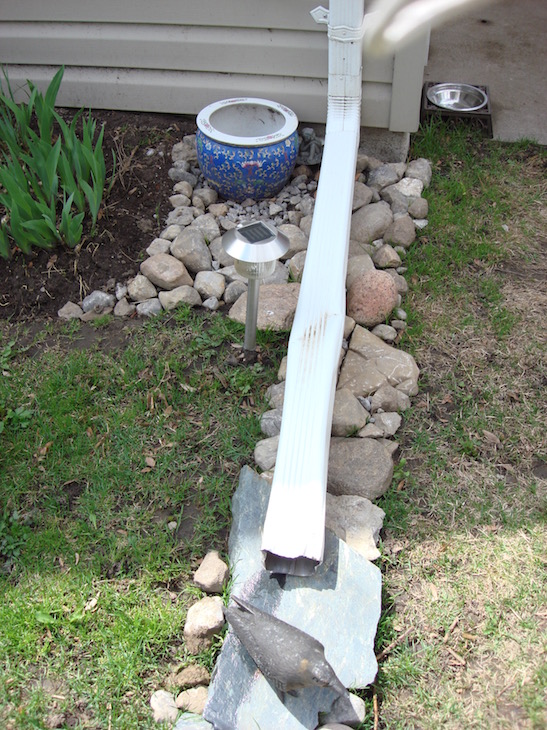
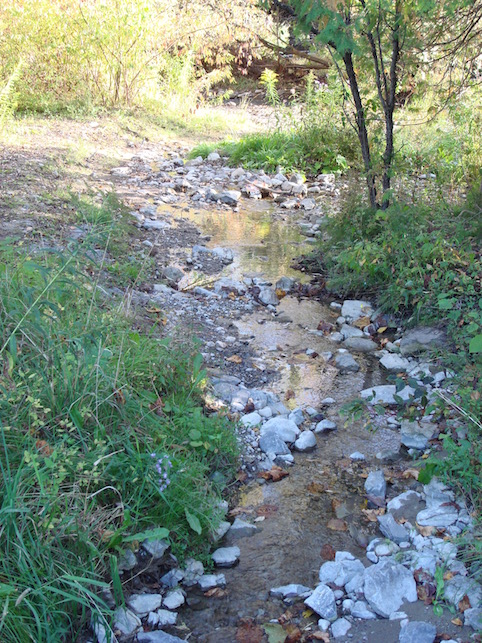
or...Nature's Rain Garden, above.
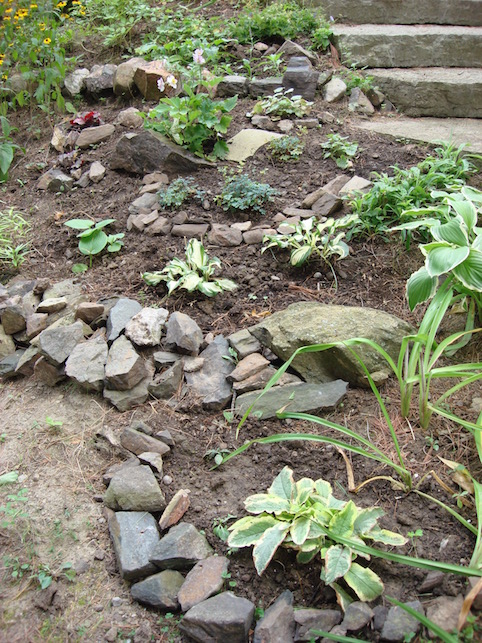
This just involves building up with what you have to slow the rain down, and encourage it to soak into the garden instead of running off and eroding the hillside.
Below, is a solution to a property that slopes toward the neighbours back garden. A deep ditch was dug and filled with various sized stones, a "bigO" wrapped in fibre cloth to keep out tiny soil particles, ending in the back corner with a deep, stone-filled dry well.
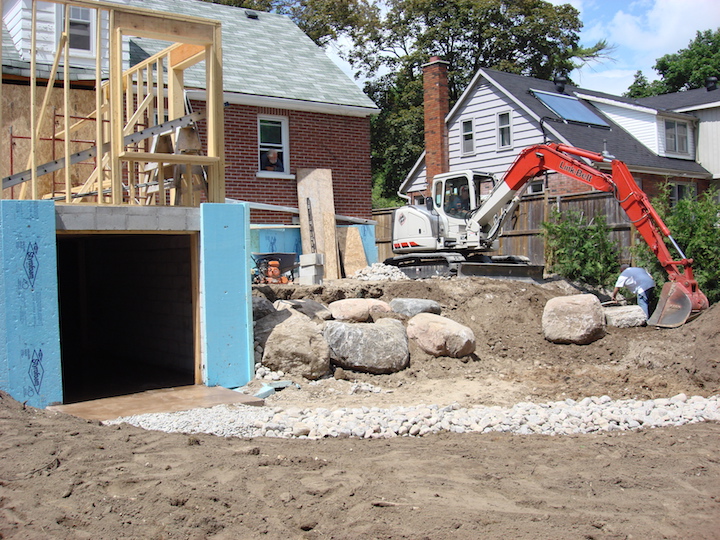
During.....
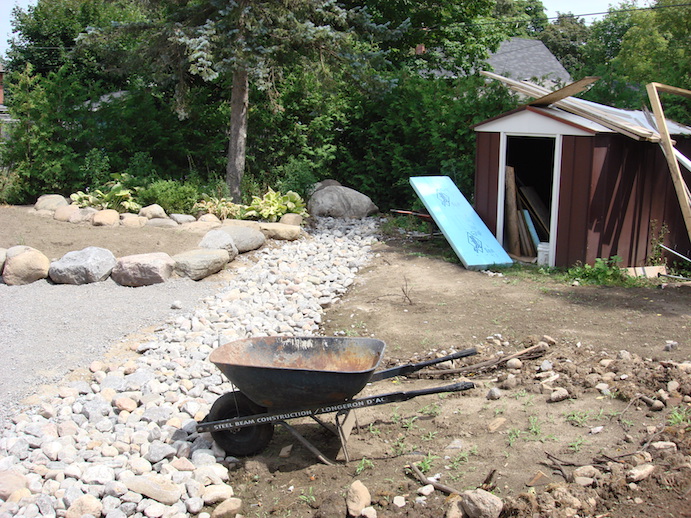
- and after....
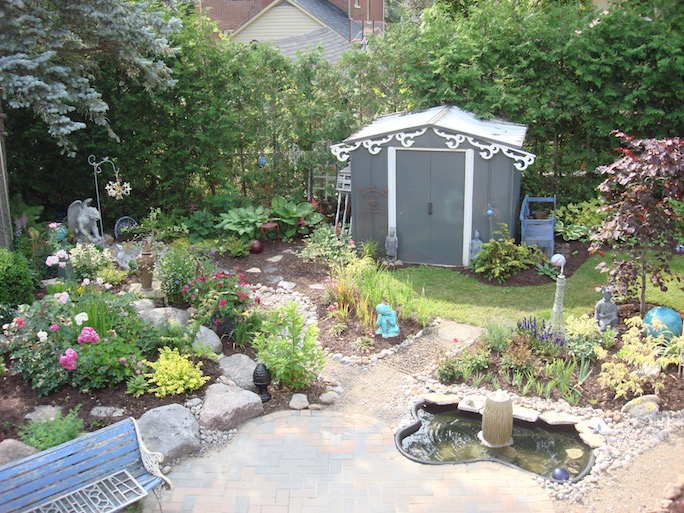
Parking lots, school grounds, new subdivisions and roads are compacted and impervious areas and lead to significant runoff, contributing as much as 70 to 80% of stormwater runoff. Some of these areas are perfect for rain gardens along with soccer fields and home gardens. De-paving parts of large parking lots and adding a rain garden can also help reduce runoff.
See what the DePave Paradise folks have done in Peterborough.
Hosted by: Peterborough GreenUP
Area “depaved”: 68 square meters
Photos by Green UP, Clifford Skarstedt, Clara Blakelock
This, below, is a "before" photo outside the building showing the pavement.
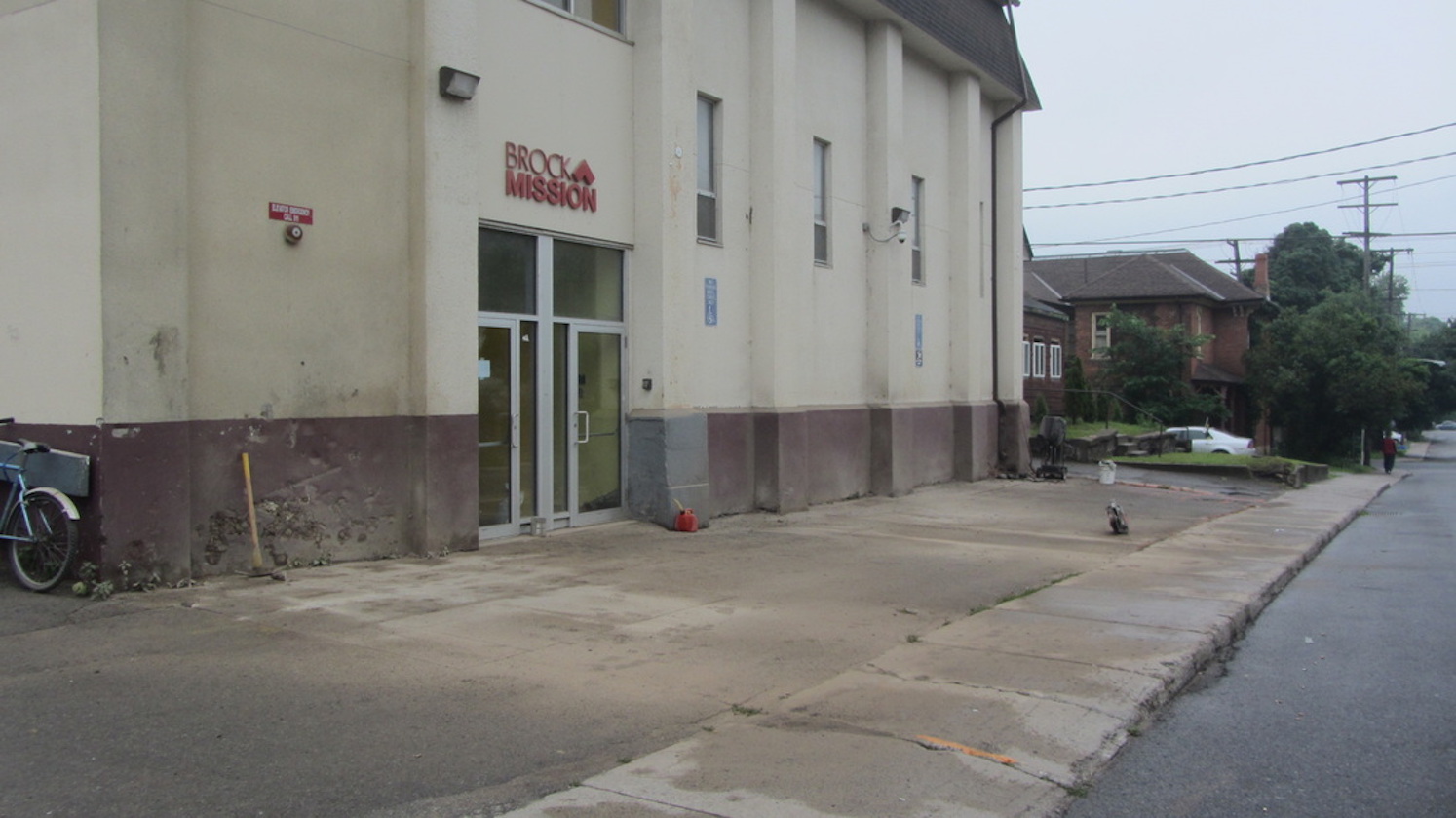
These are volunteers who are removing the pavement.
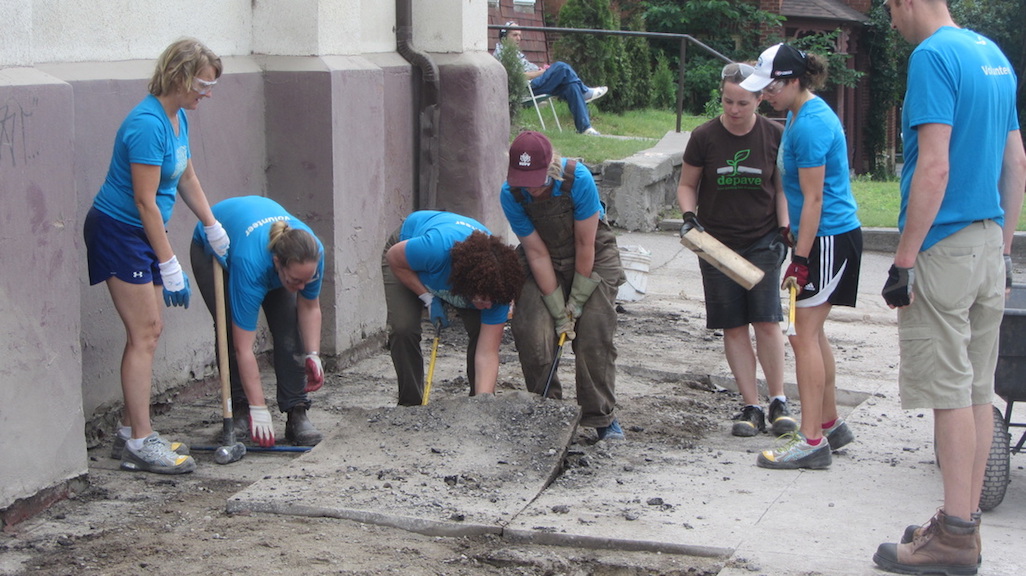
Here, we are looking down on the Rain Garden
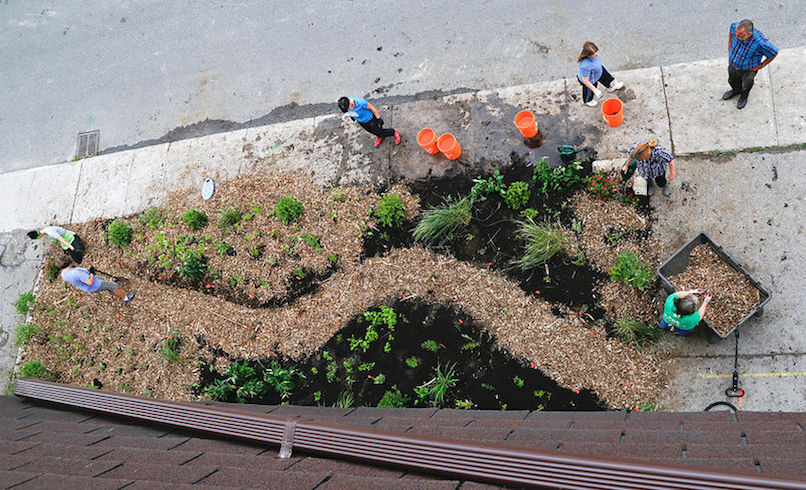
For more, look here: www.depaveparadise.ca
Here is a very large parking lot belonging to a forward-thinking business, that turned one corner into a rain garden.
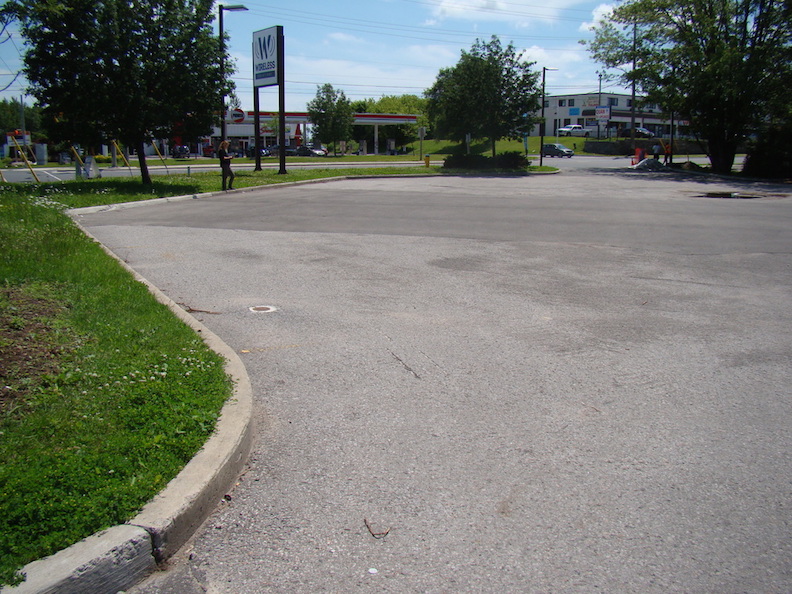
and after....
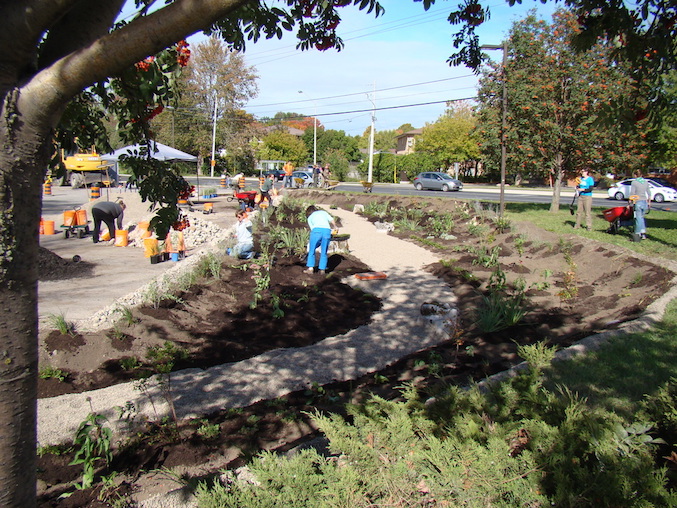
Summing up, here are some Do’s and Don’ts:
Do plant trees: tree canopies slow rainfall, and their roots absorb it.
Don’t put your downspout into city drain beside your house or it will be in your basement.
Do get a rain barrel and collect rainwater (remember to empty it before the next rain or plan ahead for any overflow)
And if you can, de-pave.
And do think about making a rain garden…
Look here for ideas:
10000 Raingardens: Public Involvement for Water Quality www.seagrant.umn.edu
There is a lot of information to help you at (www.raincommunitysolutions.ca or www.rainscaping.org or www.bluethumb.org
… or get in touch if you wish for a plant list.


